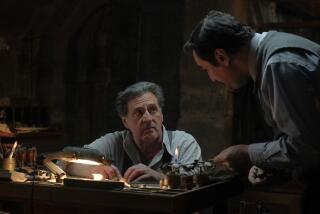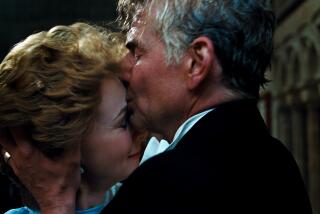John Malkovich’s ‘Seduction and Despair’ project
John Malkovich has a killer’s look in his eyes. As he methodically paces the room, the actor fixes his unblinking stare on his latest victim -- a young soprano with luminous skin and an innocent face.
Savoring the moment, Malkovich approaches the singer from behind and caresses her body. He removes a clip from her hair and inhales her scent as she nervously performs an aria from Antonio Vivaldi’s opera “Ottone in Villa.”
Malkovich wraps a reptilian arm around her neck and squeezes until she starts choking. Their bodies lock together in an almost lustful embrace. The singer, Robin Johannsen, cries for help, jolting the killer out of his reverie. He releases his grip and slumps to the floor, physically exhausted and emotionally spent.
The choreography of murder is a messy business. For Malkovich, it’s an artistically challenging one as well. The actor is playing real-life Austrian serial killer and bestselling author Jack Unterweger in a world premiere production, “Seduction and Despair,” scheduled to run this weekend at Barnum Hall Theatre in Santa Monica.
Malkovich is no one’s idea of a conventional movie star, so it should come as little surprise that when working on stage he gravitates toward projects that are eccentric and potentially disturbing. “Seduction and Despair” is an unabashedly experimental work that combines elements of theater, opera and digital video art into what its creators hope will be a new artistic form.
In the play, Malkovich delivers a monologue as the killer, who is speaking from somewhere in the afterlife. (Unterweger hanged himself in his prison cell shortly after the conviction.) Two sopranos (Johannsen and Céline Ricci) portray his victims, who take turns interrupting him with arias by Vivaldi, Haydn, Mozart and others. The orchestral accompaniment is by the Baroque music ensemble Musica Angelica, conducted by Martin Haselböck.
For Los Angeles audiences, the story has special significance.
In 1994, Unterweger was convicted of murdering nine prostitutes, including three in the L.A. area. The bodies of Shannon Exley and Irene Rodriguez were found in Boyle Heights, and the body of Peggi Jean Booth, who also used the name Sherri Ann Long, was discovered in the Malibu hills. Police determined that Unterweger had strangled his victims using their brassieres.
Malkovich, who also directs “Seduction and Despair,” describes Unterweger’s story variously as “sick,” “gruesomely funny” and “a Grimm’s fairy tale sort of saga.” In one of the production’s creepiest scenes, he will place brightly colored bras on the bodies of his victims. Later, he will enact a strangulation by tying a bra around a woman’s neck.
“His mind was an open sewer,” says Malkovich during a break in rehearsals. The actor is sitting at a wooden table that serves as the production’s only scenery. He speaks in a baritone drone that’s punctuated with long, reflective pauses.
“It’s very hard to know what goes wrong with the Unterwegers of the world,” he continues. “Obviously he was crazy, but that doesn’t necessarily excuse his actions. A dog that has rabies probably will do things it wouldn’t do if it didn’t have rabies. But that doesn’t change the fact that it has rabies.”
The idea for “Seduction and Despair” originated nearly two years ago when Malkovich first met Haselböck at a dinner at the Austrian Consulate in L.A. The two fell into a heated debate about European politics but later agreed to work together on a project that would somehow bridge Austrian culture and Southern California.
They initially came up with a “Weimar on the Pacific” theme, which they envisioned as telling the story of German-speaking artists who immigrated to the West Coast. Later, Haselböck and Malkovich narrowed the idea to the lives of Thomas and Heinrich Mann, focusing on the years that the writers spent in L.A.
A script was written in 2007, but it was set aside when Malkovich came across John Leake’s “Entering Hades,” a nonfiction book about Unterweger’s life that was published last year. Malkovich had followed the Unterweger case in the ‘90s, and the book reignited his interest in the notorious killer. The actor saw it as an opportunity to wed a contemporary and lurid subject to the Baroque style.
“I wanted a cultural trash factor in the production,” Malkovich recalls. He intended only to direct the play, but time constraints necessitated that he act in it as well. “It’s the first time I’ve directed myself, and it will be the last,” he says. “I like to remove myself from the process and see the whole picture. I can’t do that if I’m in it.”
The libretto of “Seduction and Despair” was written by the Austrian writer-director Michael Sturminger. “I was really writing the role with Malkovich in mind,” Sturminger explains in a phone interview. “I was trying to use everything I knew about John as a moviegoer -- his sense of humor and his capability of changing tone just with a glance of an eye. I don’t think the real Unterweger was half as fascinating as John is.”
Haselböck adds: “The incredible thing about John is that he can create atmosphere by just being there. When he is there, it’s a different room.”
Actors who play villains often say that they find ways to empathize with their characters in order to create a balanced performance, but Malkovich takes a different approach.
“I don’t think you have to empathize,” he says. “Their existence must be so tortured and fractured. . . . It’s not that I find violence super-removed from myself. I do understand it. We’re all animals.”
Malkovich has played refined psychopaths in such films as “In the Line of Fire” (for which he received an Oscar nomination), “Mary Reilly” and “Ripley’s Game.” But he objects to any attempt at finding a pattern in his career.
“I’ve acted in 60 or 70 films, and you’ve named three,” he says. “No offense, but I’m asked that question a lot. It makes me wonder who’s doing the repeating, me or the press.”
Malkovich says the stage has been a constant source of creative fulfillment throughout his career, dating from his beginnings at Chicago’s Steppenwolf Theatre Company. Earlier this week, he won a Molière, France’s top theater honor, for staging Zach Helm’s “Good Canary.”
The actor says he views “Seduction and Despair” as a work in progress. “I’ll need a fresh copy of the script, a pair of scissors and some glue,” he tells an assistant.
During the four-day rehearsal period, Malkovich shifts frequently between his role of actor and that of director, conferring with costume designer Birgit Hutter, with whom he worked on the 2006 film “Klimt.” For this performance, the actor will wear a stylish white suit and dark sunglasses, which was Unterweger’s playboy uniform of choiceduring the ‘90s.
He also consults with video artist Andreas Hutter, whose digital projections provide a backdrop of the subconscious. In one scene, the video follows the stretch of Sunset Boulevard from Hollywood toward Malibu that Unterweger drove on the night of one of his murders.
“I still love directing plays,” Malkovich reflects. “I love to watch good actors who surprise and amuse me. In theater, there’s unbelievable tedium followed by seconds of beauty and joy. Those moments are why you direct. Theater is so ephemeral, and I love that. You had to be there.”
More to Read
The biggest entertainment stories
Get our big stories about Hollywood, film, television, music, arts, culture and more right in your inbox as soon as they publish.
You may occasionally receive promotional content from the Los Angeles Times.







